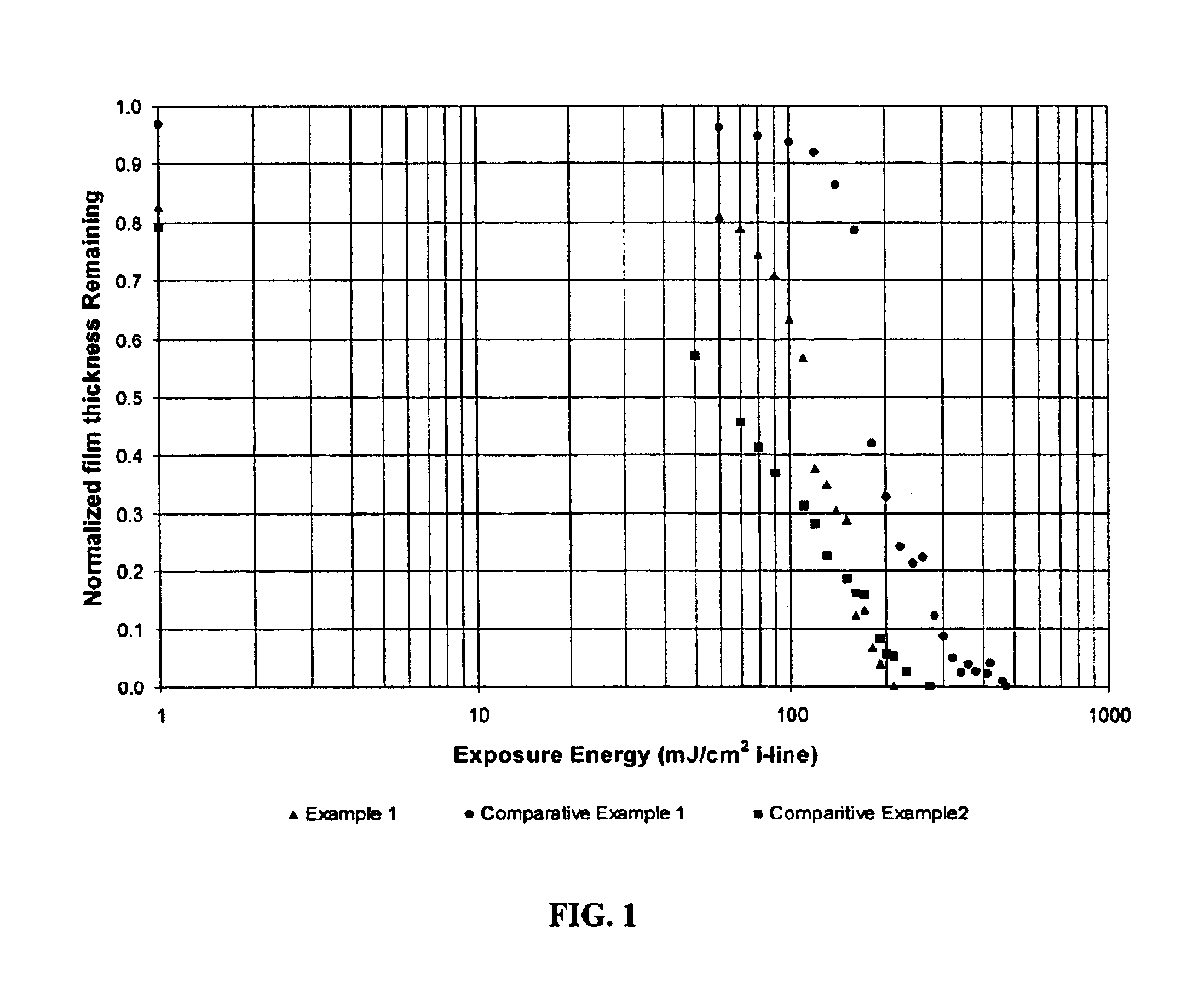Photosensitive resin compositions
a technology of resin compositions and resins, applied in the field of positive photosensitive resin compositions, can solve the problems of deteriorating image acuity, slow manufacturing process, and high exposure requirements
- Summary
- Abstract
- Description
- Claims
- Application Information
AI Technical Summary
Benefits of technology
Problems solved by technology
Method used
Image
Examples
synthesis example 1
Preparation of a Polybenzoxazole Precursor Polymer Having Structure Ia
[0061]
[0062]To a 100 mL three-necked round bottom flask equipped with a mechanical stirrer, nitrogen inlet and addition funnel, 3.66 g (10 mmol) of hexafluoro-2,2-bis(3-amino-4-hydroxyphenyl)propane, 1.70 g (21 mmol) of pyridine and 15 g of N-methyl-2-pyrrolidone (NMP) were added. The solution was stirred at room temperature until all solids dissolved and then cooled in an ice water bath at 0-5° C. To this solution, 1.01 g (5 mmol) of isophthaloyl chloride and 1.477 g (5 mmol) of 1,4-oxydibenzoyl chloride dissolved in 10 g of NMP was added drop-wise. After the addition was completed, the resulting mixture was stirred at room temperature for 18 hours. The viscous solution was precipitated in 800 mL of vigorously stirred de-ionized water. The polymer was collected by filtration and washed with de-ionized water and a water / methanol (50 / 50) mixture. The polymer was dried under vacuum at 105° C. for 24 hours. The yield...
synthesis example 2
Preparation of a Polybenzoxazole Precursor Polymer Having Structure IIa
[0063]To a 100 mL three-necked round bottom flask equipped with a mechanical stirrer, 5.42 g (10.0 mmol) of the polymer obtained in Synthesis Example 1 and 50 mL of tetrahydrofuran (THF) were added. The mixture was stirred for ten minutes and the solid was fully dissolved. 0.53 g (2 mmol) of 2,1-naphthoquinonediazide-5-sulfonyl chloride was then added and the mixture was stirred for another 10 minutes. Triethylamine, 0.2 g (2 mmol), was added gradually within 15 minutes and then the reaction mixture was stirred for 5 hours. The reaction mixture was then added gradually to 500 mL of vigorously stirred de-ionized water. The precipitated product was separated by filtration and washed with 200 mL of de-ionized water. To the product was added another 600 mL de-ionized water and the mixture vigorously stirred for 30 minutes. After filtration the product was washed with 100 mL de-ionized water. The isolated product was ...
example 1
COMPARATIVE LITHOGRAPHIC EXAMPLE 1
[0066]The following positive acting photosensitive composition was prepared: 2 g of polymer obtained in Synthesis Example 2 was dissolved in 8 g NMP and filtered. The formulation was coated into silicon wafers, softbaked at 120° C. for 3 minutes to give a film of 2.6 μm in thickness. The film was exposed with a Cannon 4000 IE i-line stepper and developed for 20 seconds using a 0.145N aqueous TMAH solution. The unexposed film thickness film retention was 97% and the Eo was 470 mJ / cm2. Contrast curve data is generated in Comparative Lithographic Example 2 and charted in the drawing FIGURE.
COMPARATIVE LITHOGRAPHIC EXAMPLE 2
[0067]The following positive acting photosensitive composition was prepared: 2 g of polymer obtained in Synthesis Example 1 and 0.5 g of PAC having structure X were dissolved in 8 g NMP and filtered.
[0068]The formulation was coated onto a silicon wafer and softbaked at 120° C. for 3 minutes to give a 4 μm thick film. The film was exp...
PUM
| Property | Measurement | Unit |
|---|---|---|
| thicknesses | aaaaa | aaaaa |
| temperature | aaaaa | aaaaa |
| thickness | aaaaa | aaaaa |
Abstract
Description
Claims
Application Information
 Login to View More
Login to View More - R&D
- Intellectual Property
- Life Sciences
- Materials
- Tech Scout
- Unparalleled Data Quality
- Higher Quality Content
- 60% Fewer Hallucinations
Browse by: Latest US Patents, China's latest patents, Technical Efficacy Thesaurus, Application Domain, Technology Topic, Popular Technical Reports.
© 2025 PatSnap. All rights reserved.Legal|Privacy policy|Modern Slavery Act Transparency Statement|Sitemap|About US| Contact US: help@patsnap.com



